Emmanuel Church, Forest Road, Loughborough
31 May 2020
Emmanuel Church was completed in 1837 at the beginning of Queen Victoria’s reign.
The church had taken two years to build at a cost of £7000. The town was expanding and a new church was needed. At that time, Loughborough was divided into two parishes, the Parish of Loughborough and the Parish of Emmanuel, Loughborough.
The original patron of both churches was Emmanuel College, Cambridge. Emmanuel Church was consecrated on 4th September 1837 by John Kaye, Bishop of Lincoln. At that time, Loughborough was part of that diocese.
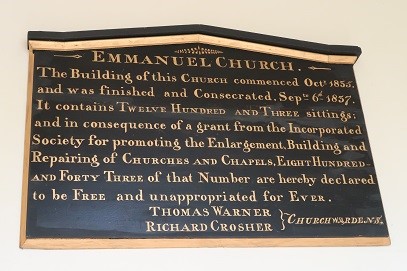
Thomas Rickman was the architect of Emmanuel Church. He is known as a major figure in the style of Gothic Revival. The church was built with a western tower and had 843 free seats for the use of the poor with 360 rented seats in the nave.
The original pews have been replaced and the church’s first small organ was replaced in 1868 by a new organ which was enlarged in 1886. There have been many more improvements since then.
In 1837, the Rector of Loughborough was Rev’d William Holme and in 1848, the first Rector of Emmanuel was Rev’d J. Robert Bunch.
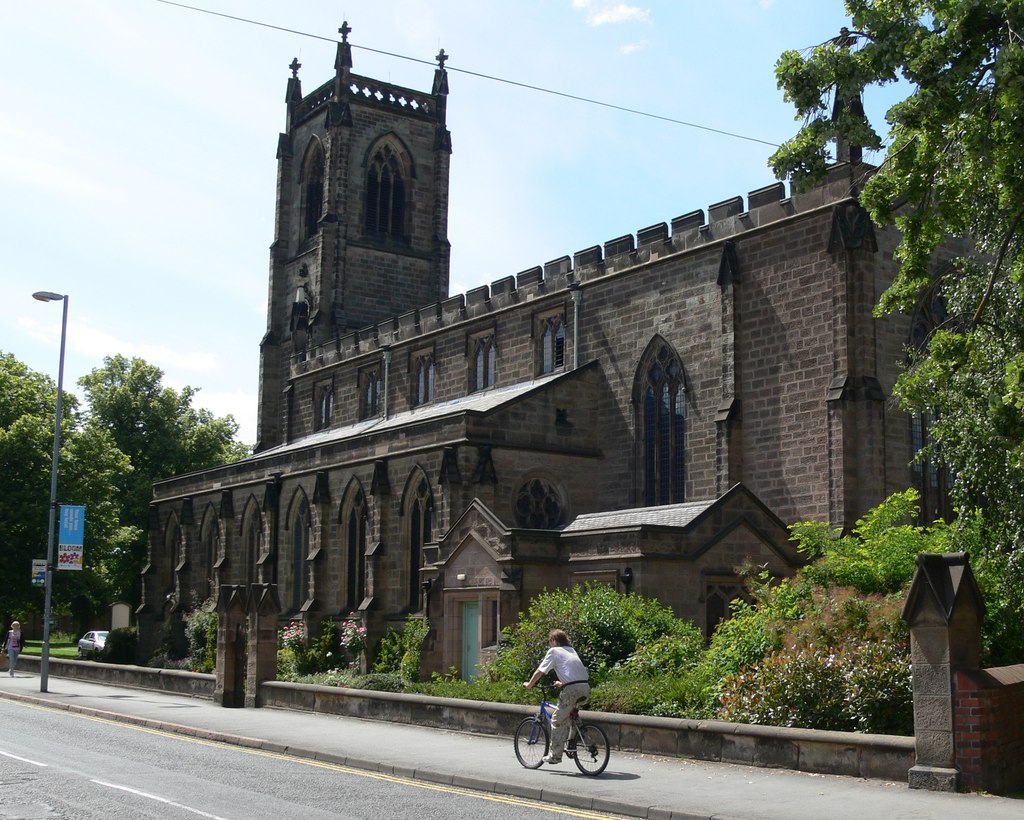
This article by Loughborough Library Local Studies Volunteers was originally featured in their exhibiton on Victorian Loughborough.
Loughborough’s Other Swimming Baths
29 May 2020
In 1849 a damning report by William Lee, a senior Inspector for the Board of Health, flagged up the appalling living conditions and prevalence of disease in parts of Loughborough.
The Report was initially poorly received and it took many years before conditions improved.
By the 1880’s there was a growing interest in the link between decent working and living conditions and general health. Illness was thought to be spread by ‘miasma’ or bad smells. Clean water and proper sewage disposal were deemed necessary for all, not just the wealthy. Exercise and personal hygiene was also thought to be beneficial.
In August 1898 the magnificent Queens Memorial Baths in what was then Island House Park, now Queens Park, were opened to great public acclaim. The Baths were the personal gift of former Loughborough Mayor Joseph Griggs. Griggs engaged architects Barrowcliffe & Allcock and builders T Barker & Sons. Messrs Messenger & Co were responsible for the heating and water. The bricks were from Tuckers Brickworks.
The baths were substantial and contained not only a large swimming pool for exercise but also a laundry and private slipper baths. These all had hot and cold water and towels were provided by an attendant. At a time when only the very wealthy had indoor, fully-plumbed bathrooms, these facilities must have seemed the epitome of luxury to the average person.
However, before these baths opened there was in fact another swimming pool in Loughborough. It was on Little Moor Lane, on the canal bank, and was opened in June 1886. There is no record of who built them or paid for them but the Loughborough Herald of 3rd June 1886 reports that the land belonged to ‘the Local Board’. It was hoped the new baths would deter men and boys swimming in the canal and causing a nuisance and hazard to the many barges and boats using it.
The building was substantial: open air, 120 feet long, 40 feet wide and a varying depth from 2 – 6 feet, lined with white glazed tiles and surrounded by a corrugated fence. A corrugated dressing hut was also built. The water fed in from the canal through some sort of filter and drained out into a brook.
Initially the baths were for men only and free to use except on Wednesdays and Fridays, when it cost one penny. Eventually the facilities were improved, though they never had a roof and were open generally from May to September. Ladies were finally admitted a few years later and various other groups arranged for private use of the pool for swimming lessons. The first attendant was a Mr Mills, an ex-army PT instructor, who lived on Moor Lane.
The Borough Council Minutes continue to report on the use of both the swimming baths in the town for many years and, even after the opening of the Memorial Baths, Moor Lane continued to be well used until the turn of the century. In 1890 the Borough of Loughborough produced byelaws ‘For the Management, Use and Regulation of the Open Bathing Places in the Borough of Loughborough.’
In the same newspaper report of 3rd June 1886 there is also mention of some Public Baths, possibly small huts with a tub of sorts and a water pump in the yard, on Victoria Street, Loughborough, owned by a Mr Greaves. They are thought to have been at the back of the White Horse public house. Mr Greaves offered use of his private baths to the public if the Council would pay for the water. However, to date no further information has been found about these baths or Mr Greaves.
by Gill Pritchard, Loughborough Library Local Studies Volunteer
Read about swimming galas at the Loughborough Baths.
See photos of nine historic UK swimming pools.
Contact us at lboro.history.heritage@gmail.com if you have information on the swimming pools on Little Moor Lane or Victoria Street

All Saints Church, Thorpe Acre
24 May 2020
All Saints Church, Thorpe Acre with Dishley serves the Thorpe Acre estate in Loughborough.
Thorpe Acre is an estate “village” that developed to house the workers on the Garendon estate. The church is situated on Thorpe Acre Road near the junction with Knightthorpe Road. The architect was William Railton and the church was consecrated in 1845. Depicting the crucifixion, the east window is by Charles Eamer Kempe and dates from 1892.
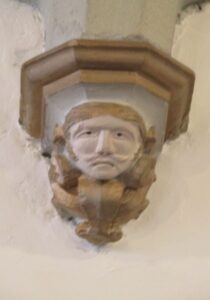
William Railton
William Railton is probably best known for being the architect responsible for Nelson’s Column but most of his output is to be found in Leicestershire.
In Loughborough, in addition to a number of lodges for the Garendon estate, he also designed All Saints Church, Thorpe Acre with Dishley, consecrated in 1845 to replace the demolished medieval church at Dishley.
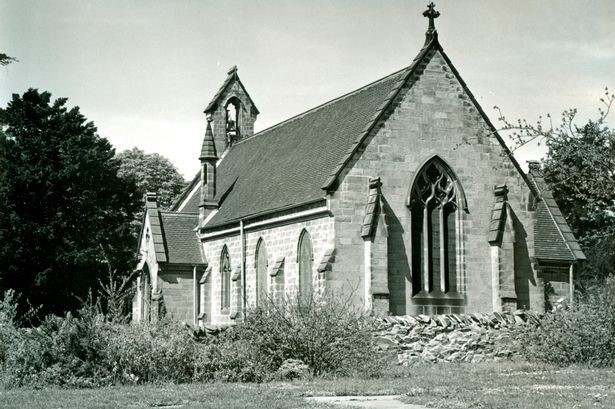
Article by Loughborough Library Local Studies Volunteers
Photographs courtesy of Tony Jarram
Do you like what we do?
23 May 2020
Loughborough History and Heritage Network is a non-profit-making entity funded and run by Alison Mott, with articles and stories contributed by members of the public.
To show appreciation for the site and help with its hosting fees, you can donate the price of a cuppa at
buymeacoff.ee/alisonmott or Ko-fi.com/alisonmott
All contributions are much appreciated!
Timeline of Victorian Loughborough
22 May 2020
1837:
VICTORIA BECOMES QUEEN
EMMANUEL CHURCH on FOREST ROAD is built at a cost of £7,000. For some years, this marked LOUGHBOROUGH’s “border” with CHARNWOOD FOREST.
The “LOUGHBOROUGH TELEGRAPH”, LOUGHBOROUGH’s earliest known newspaper, begins publication.
1838:
A new workhouse opens on DERBY ROAD, built at a cost of £7,000. It had room for 375 inmates.
EMMANUEL BOYS SCHOOL on WARDS END and EMMANUEL GIRLS SCHOOL on BEDFORD SQUARE are founded.
1839:
JOHN TAYLOR first comes to LOUGHBOROUGH to recast the ten bells of the Parish Church. He establishes a branch of the firm in Pack Horse Lane. Two extra bells are also added, making a peal of eight.
Thirty coaches a day now change horses at LOUGHBOROUGH
1840:
Opening of the MIDLAND COUNTIES RAILWAY in LOUGHBOROUGH. The first train passed through the town on May 4th.
The town’s first Post Office is run from an Inn at the corner of Market Place and Swan Street, known as the Corner Cupboard.
1841:
THOMAS COOK’s first railway excursion from LEICESTER to LOUGHBOROUGH.
The population of LOUGHBOROUGH is 10,170.
1842:
TUDOR HOUSE on WOODGATE becomes a Rosminian Convent.
1845:
ALL SAINTS CHURCH is built in THORPE ACRE.
THOMAS DENNING leaves the Lordship of the Manor of LOUGHBOROUGH to THOMAS CRADOCK in his will.
1848:
HENRY FEARON becomes Rector of ALL SAINTS PARISH CHURCH.
The parish of LOUGHBOROUGH splits into two separate parishes of ALL SAINTS and EMMANUEL.
HOLYWELL HALL is bought by Charles March Phillips.
CHARTIST leader FEARGUS O’CONNOR is prevented from speaking in the MARKET PLACE, provoking a near riot.
The SPARROW HILL THEATRE closes as a theatre.
There is an outbreak of cholera in the town.
HENRY CLEMERSON’S ironmongery shop opens in MILL STREET (now MARKET STREET), beginning a long association with the town.
1849:
LOUGHBOROUGH registers an exceptionally high death rate of 23 per 1,000.
William Lee, Superintendant Inspector of the General Board of Health, conducts an enquiry into the problems of LOUGHBOROUGH’s public health.
A small METHODIST CHAPEL is built on SWAN STREET.
1850:
The Rosminian Convent in WOODGATE moves to PARK ROAD and becomes OR LADY’S CONVENT.
SHELTHORPE COTTAGE (now The Cedars Restaurant) built for C Middleton of MIDDLETON’S BANK.
CHESTERTON HOUSE in Rectory Place becomes the first GIRLS’ GRAMMAR SCHOOL in the country.
The foundation stone of the LOUGHBOROUGH GRAMMAR SCHOOL is laid in BURTON WALKS by George Davys, Bishop of Peterborough (a native of LOUGHBOROUGH).
The LOUGHBOROUGH BOARD OF HEALTH is formed.
GRUDGINGS NEEDLE FACTORY opens in WOODGATE.
1851:
WILLIAM COTTON first patents his steam powered hosiery making machinery.
The HICKLING BLUE COAT SCHOOL opens it’s own premises on Ashby Road.
The population of LOUGHBOROUGH is 11,339.
1852:
The THOMAS BURTON GRAMMAR SCHOOL moves from CHURCH GATE to it’s present site in BURTON WALKS. By the end of the year, there are 91 boys on the school roll.
EMMANUEL INFANTS SCHOOL opens in VICTORIA STREET.
1855:
The LOUGHBOROUGH TOWN HALL and CORN EXCHANGE open in the MARKET PLACE, built at a cost of £8,812.
1856:
LOUGHBOROUGH BURIAL BOARD is established.
1857:
The town’s first drainage system is installed and gas lighting is introduced.
Demonstrations at PARLIAMENTARY HUSTINGS in the MARKET PLACE provoke the reading of the RIOT ACT and the charging of the crowd by police.
The CEMETERY opens on Leicester Road
The LOUGHBOROUGH MONITOR begins publication.
1859:
TAYLOR’S BELL FOUNDRY moves from Pack Horse Lane to FREEHOLD STREET.
1860:
The LOUGHBOROUGH POLICE STATION and COURTS open in WOODGATE at a cost of £2,500, paid for out of the county rates. Prior to this, courts were often held in the PLOUGH INN on the MARKET PLACE.
HENRY HUGHES AND CO LOCOMOTIVE WORKS opens, later to become FALCON ENGINEERING.
LOUGHBOROUGH POST OFFICE moves to MILL STREET (now MARKET STREET)
1861:
The “LOUGHBOROUGH NEWS” is first printed.
The population of LOUGHBOROUGH is 10,935.
1862:
A voluntary subscription PUBLIC DISPENSARY opens in BAXTER GATE, forming the core of today’s hospital.
£9,000 worth of restoration is carried out in the Parish Church, including the removal of all galleries, the high-backed pews and the triple-decker pulpit. There is now seating for 1,000 people. The gravestones are removed from the floor and replaced in the graveyard. W PERRY HERRICK of BEAUMANOR pays £1,000 to restore the tower.
1863:
THOMAS CRADOCK dies and is succeeded as Lord of the Manor of LOUGHBOROUGH by his son, JOHN DAVYS CRADOCK.
1864:
WILLIAM COTTON patents his new power loom.
The new UNITARIAN CHAPEL is built in VICTORIA STREET.
1866:
A FIRE STATION is built on Ashby Road.
1868:
First edition of the LOUGHBOROUGH ADVERTISER. This is later absorbed into the LOUGHBOROUGH MONITOR.
The last open Parliamentary nomination in LOUGHBOROUGH – and possibly in the country – takes place in the MARKET PLACE. The successful candidate, LORD JOHN MANNERS, was so unpopular with the crowds that he had to be escorted away under guard, pelted with eggs, rabbit skins and filth of all kinds. This incident ensured that nominations would in future be held indoors, away from the public.
1869:
The CATTLE MARKET moves from DEVONSHIRE SQUARE to GRANBY STREET.
1870:
Opening of the NANPANTAN RESERVOIR and the FEARON FOUNTAIN in the MARKET PLACE marking the town’s first piped water supply.
The LOUGHBOROUGH NEWS and LOUGHBOROUGH MONITOR amalgamate to become the LOUGHBOROUGH MONITOR AND NEWS.
LOUGHBOROUGH POST OFFICE moves to BAXTER GATE.
1871:
The last COURT LEET is held in the town
The population of LOUGHBOROUGH is 11,558.
The METHODIST CHAPEL on SWAN STREET is replaced by a larger building accommodating 600. It belongs to the PRIMITIVE METHODISTS.
1872:
The WARNER SCHOOL opens.
The old PINFOLD on PINFOLD GATE is replaced by a new one on MOOR LANE.
1873:
First publication of “WILLS LOUGHBOROUGH ALMANAC, TRADE GUIDE AND STREET DIRECTORY”.
A new organ, chamber and vestry are added to the Parish Church.
1875:
LOUGHBOROUGH cricket team is defeated by a south of England team which includes WG GRACE.
A disastrous flood hits the town when NANPANTAN RESERVOIR rises by 3 feet in 30 minutes. FOREST ROAD is described as “like a rapid, roaring river”, EMMANUEL CHURCHYARD is under water and the water in SWAN STREET vestry reaches a height of 2 feet.
The old TOLL HOUSE on the corner of Cumberland Road and Ashby Road is demolished.
The PARTICULAR BAPTISTS leave their chapel on SPARROW HILL and it is taken over by the UNITED METHODIST FREE CHURCH.
1876:
The income and trust of the HICKLING CHARITY is amalgamated with the BURTON CHARITY. The HICKLING SCHOOL closes for a time.
1877:
The HICKLING SCHOOL reopens as an intermediate school, for boys.
1878:
HOLY TRINITY CHURCH on MOOR LANE is consecrated.
1879:
The GIRLS GRAMMAR SCHOOL moves from Rectory Place to BURTON WALKS.
MR FARNHAM of QUORN gives a clock to be used on the TOWN HALL.
1880:
The LOUGHBOROUGH BOARD OF HEALTH buys the Manorial Rights of LOUGHBOROUGH from JOHN DAVYS CRADOCK. The people of the town finally become Lord of themselves!
First edition of the LOUGHBOROUGH HERALD, later to be absorbed into the LOUGHBOROUGH MONITOR.
One of the last thatched timber frame houses in the centre of town is demolished. This was on the corner of FENNEL STREET and CHURCH GATE, on the site of what is now THE LEFT LEGGED PINEAPPLE.
1881:
“GREAT PAUL” is cast by TAYLOR’S BELL FOUNDRY for ST PAUL’S CATHEDRAL.
LOUGHBOROUGH AND DISTRICT BOATING CLUB is founded.
The population of LOUGHBOROUGH is 14,803.
1883:
The FALCON ENGINEERING AND CAR WORKS opens.
The CHARNWOOD FOREST RAILWAY opens out of DERBY ROAD STATION.
1884:
Drought hits LOUGHBOROUGH and NANPANTAN RESERVOIR dries up. An emergency water supply has to be obtained via filter beds in BURLEIGH BROOK. It is six weeks before a snow fall and rapid thaw eases the situation.
1885:
Death of ARCHDEACON HENRY FEARON.
The FREE LIBRARY opens on the corner of GREENCLOSE LANE.
1887:
A voluntary soup kitchen is established to help the poor and unemployed. This is to last until the outbreak of the First World War.
The town’s first steam fire engine is purchased after the destruction of the Nottingham manufacturing Company in a fire.
CLEMERSONS expands into larger premises, making it the first Department Store in LOUGHBOROUGH. They were also the first to use electric lighting, provided by their own generator.
1888:
LOUGHBOROUGH IS INCORPORATED AS THE BOROUGH OF LOUGHBOROUGH. The first Mayor of the new Borough is ALDERMAN JOSEPH GRIGGS.
1889:
BRUSH ENGINEERING opens at the FALCON WORKS.
The Mayor and Burgesses of LOUGHBOROUGH buy the TOWN HALL for the town at a cost of £5,000 – £3,812 LESS than it cost to build!.
ST PETER’S CHURCH opens in STORER ROAD.
The PHILHARMONIC HALL opens on SOUTHFIELDS ROAD.
1890:
CHURCH GATE becomes the first road in LOUGHBOROUGH to be surfaced with tarmac.
Floods badly disrupt train services on the MIDLAND LINE.
1891:
The population of LOUGHBOROUGH is 18,196.
The first edition of the LOUGHBOROUGH ECHO is published as a “free sheet”.
The LOWE family take over the “GREAT HOUSE” for their antique business.
26th Oct – Barnum & Bailey’s Circus comes to town, stopping traffic in the streets.
1892:
2,000 people are now employed at CARTWRIGHT AND WARNER’s Hosiery Mill on NOTTINGHAM ROAD.
A bad fire breaks out at TAYLORS BELL FOUNDRY.
1893:
The MIDDLETON BANK building on Market Place is demolished.
1894:
LOUGHBOROUGH GIRLS GRAMMAR SCHOOL is renamed LOUGHBOROUGH HIGH SCHOOL.
LOUGHBOROUGH TOWN FOOTBALL CLUB defeats ASTON VILLA 2-1 in the Birmingham Cup in front of a crowd of 6,000. Unfortunately they went on to lose 6-1 to WEST BROMWICH ALBION in the semi-final!
The QUORN HUNT meets in the MARKET PLACE for the first time.
1895:
The generation of electricity begins in Empress Road.
1896:
The CATTLE MARKET is built in GRANBY STREET.
The NEW THEATRE on ASHBY ROAD opens with “JACK OF HEARTS”
1897:Queen Victoria’s Diamond Jubilee
1898:
An Act is passed for the construction of BLACKBROOK RESERVOIR.
ALDERMAN GRIGGS donates the GRANBY STREET SWIMMING BATHS to the town as part of QUEEN VICTORIA’s DIAMOND JUBILEE celebrations.
1899:
The GREAT CENTRAL RAILWAY opens.
The LOUGHBOROUGH CORPORATION ACT is passed, allowing the municipal (and compulsory) take-over of gas making and supply; electricity generating and supply and the building of a tramway. Control of the GAS COMPANY costs them £102,154.
QUEEN’S PARK opens on Granby Street.
1900:
HERBERT MORRIS AND BESTERT LTD move to LOUGHBOROUGH from LONDON.
The construction of the BLACKBROOK RESERVOIR begins.
The population of LOUGHBOROUGH is 21,508.
1901:
QUEEN VICTORIA DIES AND EDWARD VII BECOMES KING
Victorian Loughborough
21 May 2020
In Autumn 2019 Loughborough Library Local Studies Volunteer group staged an exhibiton about Victorian Loughborough at Loughborough Library .
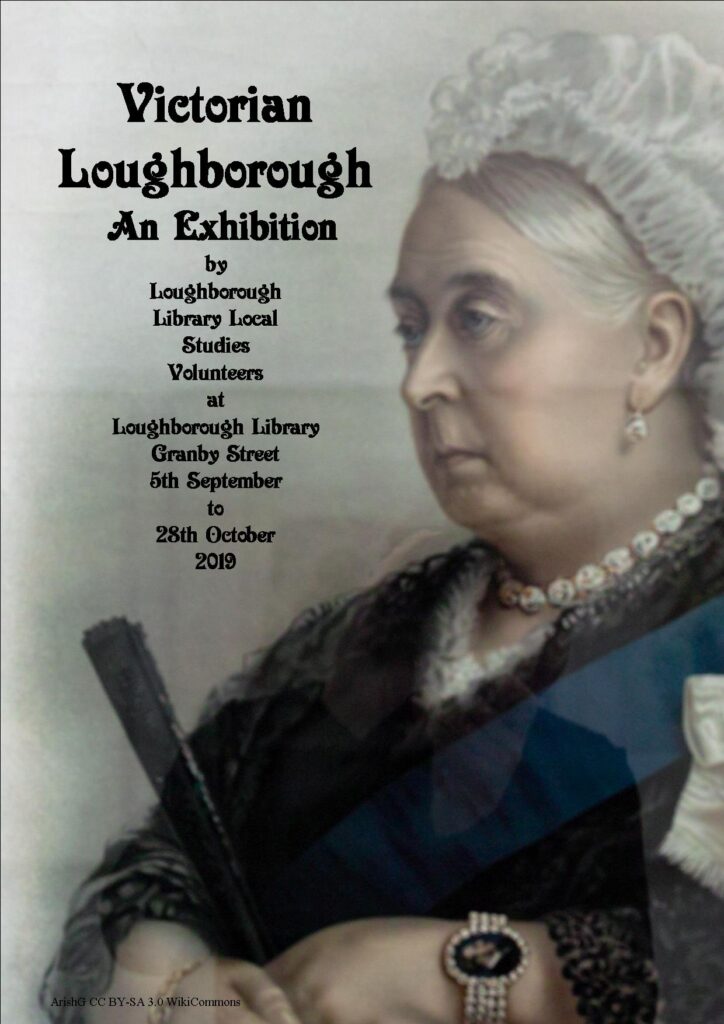
The group have kindly shared much of the information from that exhibition with us for publishing on this website, including pieces about local churches during the period.
As part of the exhibition, they put together a very comprehensive timeline of events in the town during Victoria’s reign.
See that timeline here.
Find a downloadable copy here.
The Methodist Church in Loughborough: a history
17 May 2020
The Methodist Church is the fourth largest Christian Church in Britain with more than six thousand churches and a total membership of around three hundred and thirty thousand people.
Established in the mid-eighteenth century, Methodism challenged the religious assumptions of the established church and had a major impact on the development of the early working-class movement.
Loughborough’s association with Methodism can be traced back to its beginnings, with both John Wesley and, later, Hugh Bourne known to have paid many visits to the town.
Dr Karen Ette, Methodist Lay Chaplain at Loughborough University, has documented the rise of the Methodist movement in Loughborough, as evidenced by the chapels built in the town over time to accommodate the growing congregation.
Read Dr Ette’s article here.
Find out about the Loughborough Methodist Circuit in current times here.
Read about the history of Methodism in Rothley here.
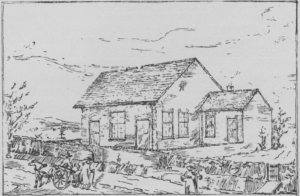
Karen Ette is the author of ‘Don’t Be Late in the Morning’, the first and only novel written about the Leicestershire Regiment in World War 1. The book is available from Charnwood Museum, from Goldcrest Books, Amazon, or by emailing the author at drkarenette@gmail.com.
‘Have you got your ration book?’ WW2 Loughborough as I Remember it #5
14 May 2020
‘Housewives had a very difficult time during the war. Shopping was a nightmare, with most things being rationed. A person living alone fared the worst, they were such small amounts. I remember a grey-looking concoction called cooking fat. We were allocated two ounces per week. Many other commodities were in very small amounts. Anything that wasn’t rationed attracted long queues.’
‘When rationing came I used all our ration books to buy whatever food there was. If my memory is correct the meat ration was 3 oz for each ration book every week. I often queued at the butcher’s shop in Leicester Road for tripe when there was no meat. The shops in the Market Place included Liptons where I bought eggs, one dozen for 2/-. At Maypoles you could watch the butter being patted into shape; you could have 2 oz for each ration book every week.’
‘I remember rushing out of work to wait with hundreds outside Woolworths as the word had spread around the town that the store had some bars of soap. After half an hour I managed to buy some shaving soap and a packet of hairgrips and some ‘Dinky’ hair curlers and a snood. These were very rare commodities and I ran home to show my mum. Treasures indeed!’
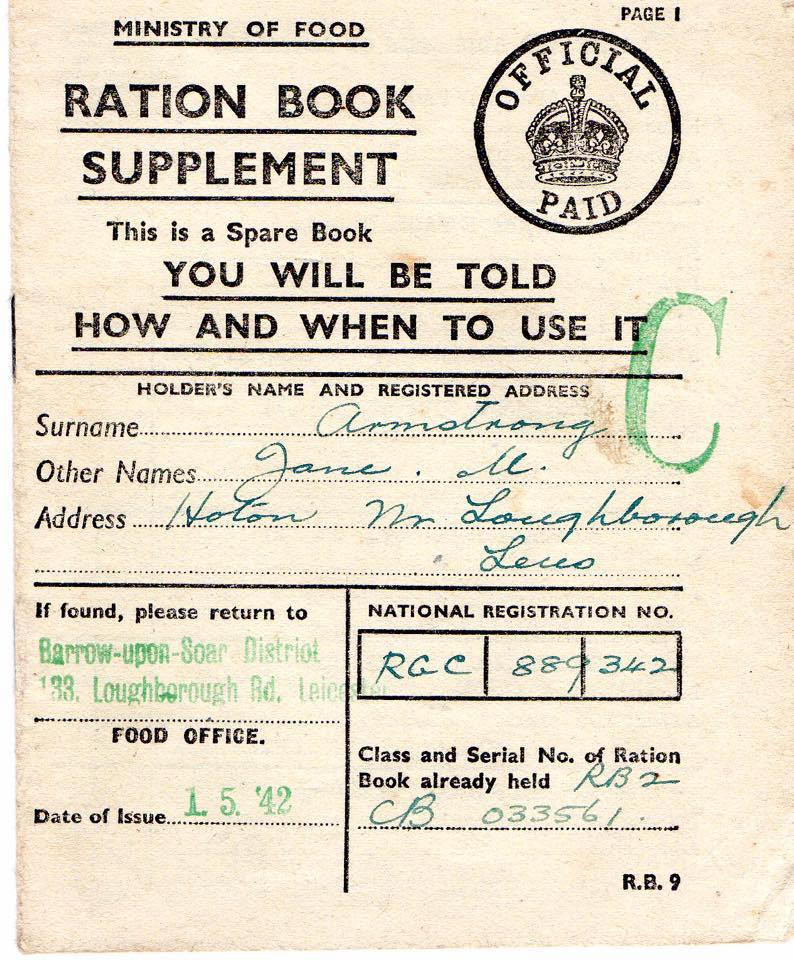
Remember Loughborough Facebook Group member Janet Plummer‘s mother Goldie Wright worked in the food office in Loughborough, which Janet believes was somewhere at the Market Place-end of Granby Street.
‘When the little refugees came to Loughborough by train, the Town Hall was set up for them to be issued with ration books. Mum told me she was so emotional to see these confused little children dragging their belongings she was sent home.’
Learn more about rationing here and sweet rationing in WW2 here.
Main text (contributors unknown) taken from: ‘Loughborough As I Remember It,’ edited by Jean Carswell. Pub. Leicestershire Libraries and Information Service, 1989. ISBN 085 022 270 2.
Email us at lboro.history.heritage@gmail.com if you have photos or stories we could add to this post.
Fire, fire! WW2 Loughborough as I Remember it #4
13 May 2020
‘When the war broke out my husband and I both joined the fire fighters and took our turn on look out.’
‘The shelter was where the bus station is now (currently The Rushes Shopping Centre) and although we went in it and directed other people to it, we preferred to take our chances together at home, instead of sleeping on the floor during an air raid.’
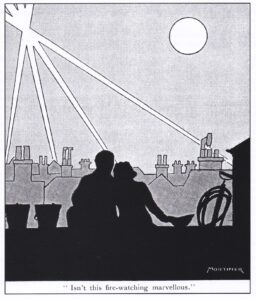
(Pub. Loughborough Archaeological and Historical Society, 2006)
Read John Cory’s memories of being in Loughborough’s Home Guard here.
Read an article about the bombing of Leicester’s Freeman Hardy and Willis Factory here.
Extracts from: ‘Loughborough As I Remember It,’ (unknown contributors) edited by Jean Carswell. Pub. Leicestershire Libraries and Information Service, 1989. ISBN 085 022 270 2.
Email us at lboro.history.heritage@gmail.com if you have photos or stories we could add to this post.
Any Old Iron: WW2 Loughborough as I Remember it #3
12 May 2020
‘There was a nursery on the Southfields Green area for mothers to take their children whilst they helped the war effort by making ammunition in the factories. Our front iron railings were taken away to be used in the factories along with everyone elses and we were so short of the things one now takes for granted.’
Were the railings really taken for the war effort or as a propognda exercise? Read an article by the London Parks and Garden Trust about it here.
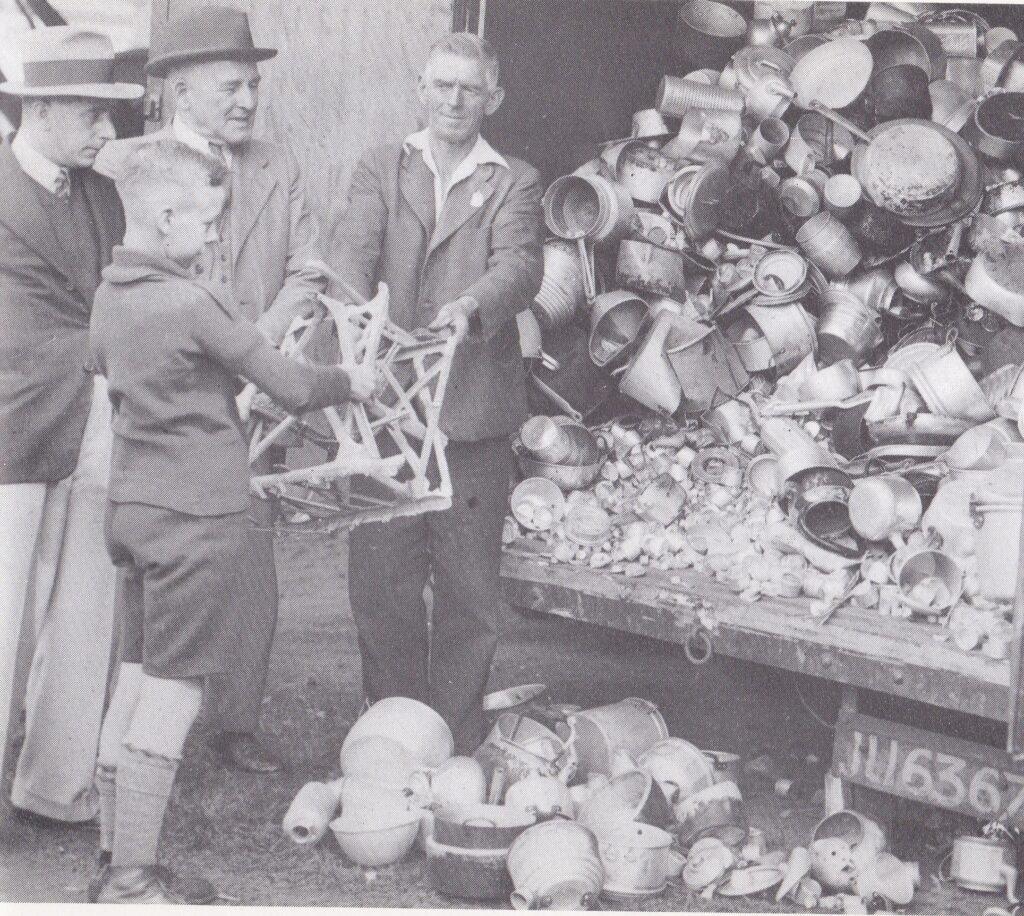
Text (unknown contributor) from: ‘Loughborough As I Remember It,’ edited by Jean Carswell. Pub. Leicestershire Libraries and Information Service, 1989. ISBN 085 022 270 2.
Image from ‘Bygone Loughborough in Photographs, Vol 2.’ Pub. Leics Libraries and Information Services 1975.
Email us at lboro.history.heritage@gmail.com if you have photos or stories we could add to this post.